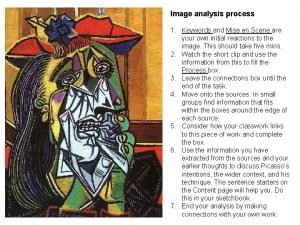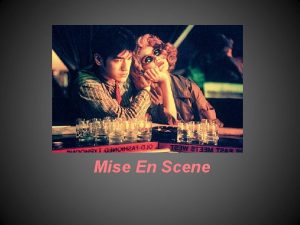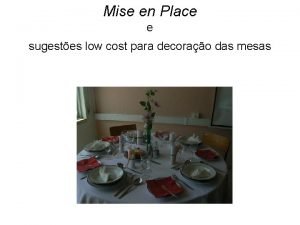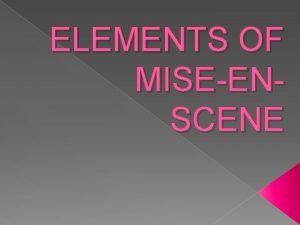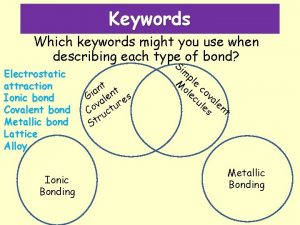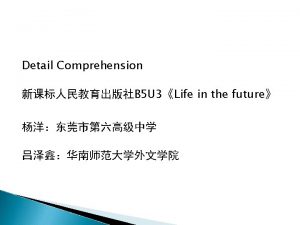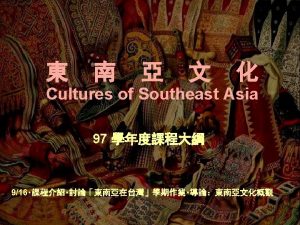Image analysis process 1 Keywords and Mise en






- Slides: 6

Image analysis process 1. Keywords and Mise en Scene are your own initial reactions to the image. This should take five mins. 2. Watch the short clip and use the information from this to fill the Process box. 3. Leave the connections box until the end of the task. 4. Move onto the sources. In small groups find information that fits within the boxes around the edge of each source. 5. Consider how your classwork links to this piece of work and complete the box. 6. Use the information you have extracted from the sources and your earlier thoughts to discuss Picasso’s intentions, the wider context, and his technique. The sentence starters on the Content page will help you. Do this in your sketchbook. 7. End your analysis by making connections with your own work.

Image Analysis: Writing Frame Process Mise en Scene What has the artist used to make the art work? Consider the materials and media. Has it been presented in a special way I. e. as an installation? (“Setting in Scene”) Look carefully at the picture and write a paragraph explaining what is going on in the scene from an objective/impartial viewpoint. Imagine you are trying to explain the art work to someone over the telephone Connections Keywords How does this work connect with either the overall theme of the project or your own work? You may be inspired by the artist’s concept, use of media, subject, location, composition etc… Write down a list of 5 -10 keywords in response to this picture: TITLE: Weeping Woman DATE: 1937 ARTIST: Pablo Picasso Title: How does the title of the work contribute to your understanding of the work?

Source 1 Information about the time the work was created. The Weeping Woman series is regarded as a continuation of the tragedy depicted in Picasso's epic painting Guernica. In focusing on the image of a woman crying, the artist was no longer painting the effects of the Spanish Civil War directly, but rather referring to a singular universal image of suffering. Any information that helps you discuss one particular image. Picasso's insistence that we imagine ourselves into the excoriated face of this woman, into her dark eyes, was part of his response to seeing newspaper photographs of the Luftwaffe's bombing of Guernica on behalf of Franco in the Spanish civil war on April 26, 1937. The Weeping Woman, 1937 came at the end of the series of paintings, prints and drawings that Picasso made in protest. It has very personal, Spanish sources. Examples of the wider issues that the artist is addressing. A statement that sums up Picasso’s intentions. In May 1937 Picasso's mother wrote to him from Barcelona that smoke from the burning city during the fighting made her eyes water. The Mater Dolorosa, the weeping Virgin, is a traditional image in Spanish art, often represented in lurid baroque sculptures with glass tears, like the very solid one that flows towards this woman's right ear. Picasso's father, an artist, made one for the family home. The model for the painting, indeed for the entire series, was Dora Maar, who was working as a professional photographer when Picasso met her in 1936; she was the only photographer allowed to document the successive stages of Guernica while Picasso painted it in 1937. Dora Maar was Picasso's mistress from 1936 until 1944. In the course of their relationship, Picasso painted her in a number of guises, some realistic, some benign, others tortured or threatening. Picasso explained: “For me she's the weeping woman. For years I've painted her in tortured forms, not through sadism, and not with pleasure, either; just obeying a vision that forced itself on me. It was the deep reality, not the superficial one. . . Dora, for me, was always a weeping woman. . And it's important, because women are suffering machines. ” Words and phrases that are repeated in each source.

Source 2 Information about the time the work was created. • • Examples of the wider issues that the artist is addressing. • A statement that sums up Picasso’s intentions. Picasso returned to theme of the Weeping Woman, first seen in Guernica clutching the body of her dead child, in a series of drawings, etchings and paintings made in September and October of 1937. These unsettling, emotive works are often read simplistically as mere descriptions of Dora's fiery temperament and the volatile nature of her relationship with Picasso. They are, however, far more complex and explore the fascinating dynamic between the works, the artist and the model. While the Weeping Women series embodies the essence of Picasso's beloved muse, Dora, it can also be read as a self– portrait revealing the inner torment of a man haunted by horrific images of the massacres taking place in the Spanish Civil War. In the artistic partnership between Dora and Picasso we again see the special empathy between the lovers, where Dora is not simply a model but an impassioned political accomplice committed to conveying a powerful, universal message condemning war. Dora willingly submits her features to be brutally distorted and deconstructed by Picasso who contorts her beauty into a harsh ugliness to arouse raw human emotions of anguish, compassion and despair. While the Weeping Women vary enormously in colour and technique, the intensity of the expression in her eyes in each painting remains unchanged. In the image the woman’s eyes are staring out of their sockets. Picasso used this in his work as a symbol of awkward pain. In this particularly bold version Picasso has used an unsettling combination of acid greens and vibrant mauves exaggerated by thick black outlines. The startled eyes, rimmed with black eyelashes like Dora's, are popping out of giant boat–like sockets tilted slightly to suggest crying. The triangular nose and sharp, pointed handkerchief express raw grief, while the confined space in which the woman finds herself seems to suggest the stifling claustrophobia of war and an inability to escape Any information that helps you discuss one particular image. Words and phrases that are repeated in each source.

Source 3 Information about the time the work was created. Examples of the wider issues that the artist is addressing. A statement that sums up Picasso’s intentions. This is a study of how much pain can be communicated by a human face. It has the features of a specific person, Dora Maar, whom Picasso described as "always weeping". She was in fact his close collaborator in the time of his life when he was most involved with politics. Let your eyes wander over the sharp surface and you are led by the jagged black lines to the picture's centre, her mouth and chin, where the flesh seems to have been peeled away by corrosive tears to reveal hard white bone. The handkerchief she stuffs in her mouth is like a shard of glass. Her eyes are black apertures. When you are inside this picture you are inside pain; it hits you like a punch in the stomach. Picasso's insistence that we imagine ourselves into the excoriated face of this woman, into her dark eyes, was part of his response to seeing newspaper photographs of the Luftwaffe's bombing of Guernica on behalf of Franco in the Spanish civil war on April 26, 1937. This painting came at the end of the series of paintings, prints and drawings that Picasso made in protest. It has very personal, Spanish sources. In May 1937 Picasso's mother wrote to him from Barcelona that smoke from the burning city during the fighting made her eyes water. The Mater Dolorosa, the weeping Virgin, is a traditional image in Spanish art, often represented in lurid baroque sculptures with glass tears, like the very solid one that flows towards this woman's right ear. Picasso's father, an artist, made one for the family home. This painting takes such associations and chews them to pulp. It is about the violence that we feel when we look at it, about translating the rawest human emotion into paint. Its origins lie in the tortured figures of Picasso's Guernica (1937), whose suffering is calculated to convey you beyond the photographs of the bombing to sense momentarily what it was to be there. In Guernica there is a screaming woman holding her dead baby, her tongue a dagger pointing at heaven. The baby's face is a cartoon of death. Picasso followed Guernica with his series of Weeping Woman paintings in which the woman's mourning continues, without end. She cries and cries. In different versions the Weeping Woman's face is crushed to an abject lump, twisted out of recognition. Any information that helps you discuss one particular image. Words and phrases that are repeated in each source.

Content What do you think are Picasso’s intentions? There may be more than one. ‘PEC’ each intention. P Picasso intended to… E He did this by… (describe something in the image) C He wanted us to think / react … What wider social, political or cultural issues was Picasso addressing? P Picasso is considering ______ in this piece of work. E This is shown by _____ C He wanted to explore _____ How do the materials and techniques used by Picasso support the work and the artist’s intentions? (This could include scale, composition as well as the particular process. ) P Picasso has used ______ in creating this work. E This creates a ______ effect. C This helps to support his point about _____
